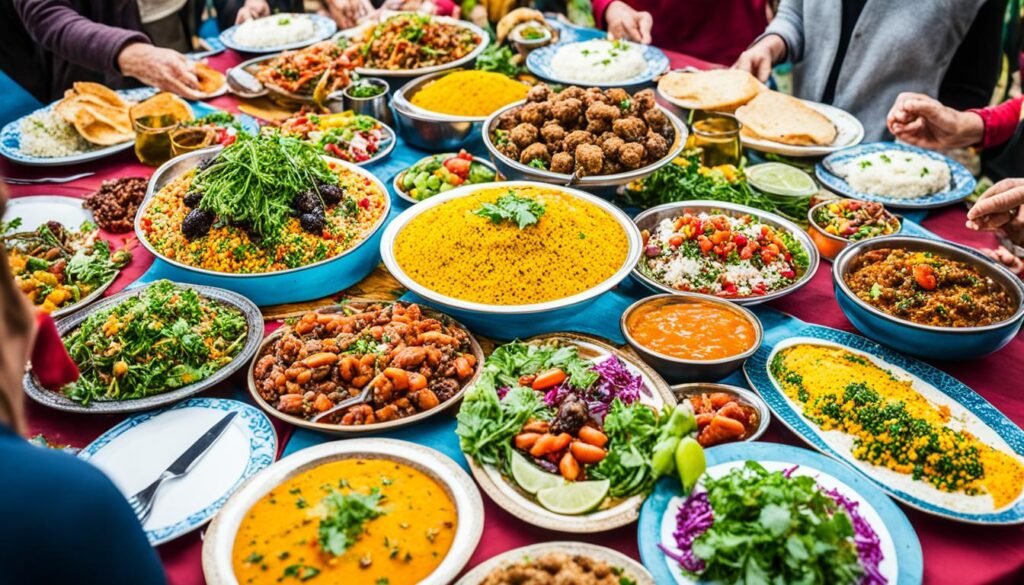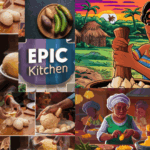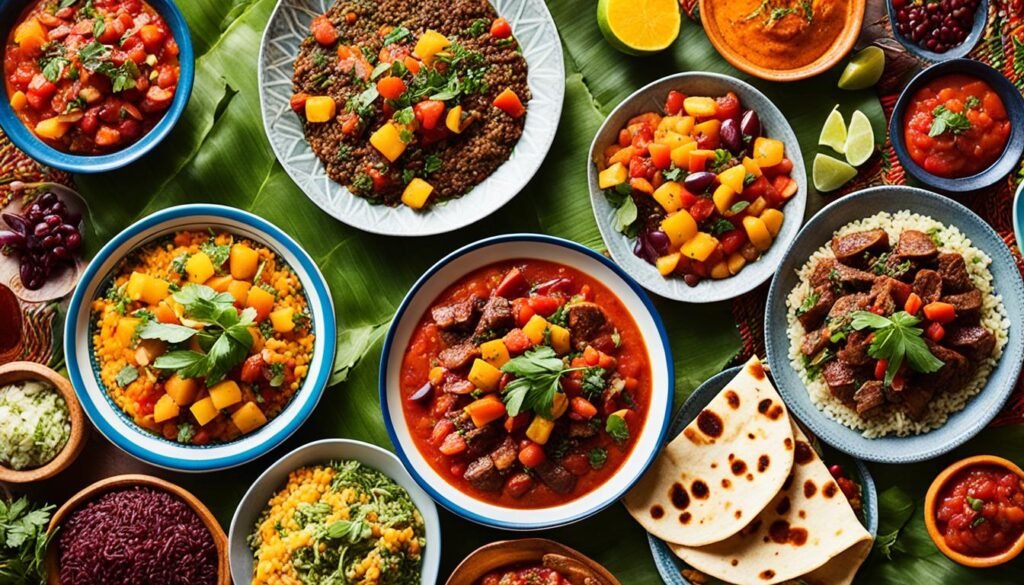Embark on a tantalizing journey through East Africa’s diverse culinary landscape, where tradition meets global flavors. Each country in East Africa, including Eritrea, Tanzania, Kenya, Uganda, Rwanda, Burundi, South Sudan, Ethiopia, and Somalia, boasts a rich culinary heritage and unique cultural practices that have shaped its traditional foods. From the spongy injera of Ethiopia to the flavorful nyama choma of Kenya, the cuisines of East Africa take you on a captivating culinary adventure.
Key Takeaways
- East Africa is a region rich in culinary heritage and cultural practices.
- Countries like Eritrea, Tanzania, Kenya, Uganda, Rwanda, Burundi, South Sudan, Ethiopia, and Somalia offer a diverse array of traditional foods.
- Injera and nyama choma are examples of iconic dishes from Ethiopia and Kenya, respectively.
- Exploring East African cuisines exposes you to a melting pot of flavors influenced by centuries of trade and cultural exchange.
- East African street food is a must-try, featuring dishes like Rolex, Smokie Pasua, Mutura, Viazi Karai, and more.
The Influence of Trade and Cultural Exchange on East African Flavors
East African street food is a testament to centuries of trade and cultural exchange. Throughout history, the region’s flavors have been shaped by the intricate web of connections established through the Silk Road and the culinary legacies of Arab, Indian, and European settlers.
Aromatic spices and fragrant herbs from different corners of the world have intermingled with indigenous ingredients, resulting in a vibrant and diverse culinary landscape that reflects the cross-cultural encounters in East Africa.
“The flavors found in East African street food represent the shared history of explorers, traders, and settlers who journeyed through the region,” says renowned food historian Dr. Zawadi Lemeit. “These culinary traditions are a testimony to the cultural fusion that took place over centuries.”
East African street food combines bold and fiery spices, earthy flavors, and a harmonious balance of sweet and savory elements. The blending of culinary influences is evident in dishes like pilau, a fragrant rice dish with Indian origins, and chapati, a greasy flatbread inspired by Arab cuisine.
The fusion of ingredients and techniques from different cultures has not only enriched the flavors of East African street food but has also created a sense of shared heritage and unity among diverse communities.
For example, the ubiquitous presence of street vendors selling samosas, a deep-fried pastry stuffed with spiced meat or vegetables, highlights the cultural links between East Africa and the Indian subcontinent. This cross-pollination of flavors and cooking methods has resulted in an exciting gastronomic experience for both locals and visitors alike.
The Cultural Exchange of Spices and Flavors
The exchange of spices has been a cornerstone of East African culinary heritage. The introduction of spices like cinnamon, cumin, cardamom, and cloves during the Arab and Indian spice trade revolutionized the flavors of the region’s cuisines.
The influence of these aromatic spices is seen in popular East African dishes like biryani, a fragrant rice dish layered with meat or vegetables and adorned with a medley of spices. The complex spice blends used in dishes like berbere and garam masala add depth and complexity to the flavors, making East African street food a true sensory delight.
Indigenous Ingredients and Global Techniques
While cultural exchange has played a significant role in shaping East African flavors, the region’s indigenous ingredients continue to shine. Staples like plantains, groundnuts, yams, maize, and sorghum are integral components of the local cuisine.
The integration of global techniques, such as grilling, frying, and stewing, with indigenous ingredients has resulted in unique street food offerings. For instance, nyama choma, a Kenyan grilled meat dish, showcases East Africa’s love for succulent meats marinated in a blend of local spices and cooked over an open flame.
The blending of cultures and flavors in East African street food is a testament to the spirit of inclusivity and openness that characterizes the region. Through the centuries, the exchange of ideas through trade has created a culinary tapestry that embraces diversity and celebrates the shared history of East Africa and the wider world.
Must-Try East African Street Foods
East African street food offers a delightful array of dishes to savor. From the rolled omelette called Rolex in Uganda to the grilled sausages of Smokie Pasua in Kenya, these street foods are a popular choice among locals and visitors alike. The distinct flavors and vibrant spices of East African cuisine come together in these street foods, tempting taste buds and providing a true gastronomic experience.
One must-try street food is Mutura, a savory snack made with minced meat and offal. It is a favorite among locals and is often enjoyed with a side of viazi karai, deep-fried spiced potato balls that are crispy on the outside and soft on the inside. These flavorful bites are perfect for satisfying your cravings while exploring the streets of East Africa.
For those with a love for savory treats, samosas are a must. These triangular pastries are filled with a variety of ingredients such as vegetables, meat, or cheese, and are fried to perfection. Crispy on the outside and packed with flavor on the inside, samosas are a popular snack enjoyed by many.
Another street food favorite is maize. Whether roasted on the cob or ground into flour and used to make porridge, maize is a staple in East African street food. The sweet and nutty flavor of maize adds a unique touch to the culinary scene in the region.
Don’t forget to try mshikakis, skewered meats marinated in a flavorful mix of spices. These grilled delights are a popular street food choice and are often enjoyed with a side of bhajia, deep-fried potato fritters seasoned with aromatic spices.
And of course, no street food adventure in East Africa is complete without indulging in some chips mwitu. These “wild fries” are a local specialty, often found at roadside stalls. Made from locally grown potatoes and seasoned with a blend of spices, chips mwitu hit the spot and satisfy your cravings for a quick and delicious snack.
“East African street food is a celebration of flavors and culture. From the bold spices to the innovative flavor combinations, each bite tells a story of the region’s culinary heritage.”
– Local Food Enthusiast
A Taste of East Africa: Must-Try Street Foods
| Street Food | Country of Origin |
|---|---|
| Rolex | Uganda |
| Smokie Pasua | Kenya |
| Mutura | Kenya |
| Viazi Karai | Tanzania |
| Samosas | Various East African countries |
| Maize | Various East African countries |
| Mshikakis | Various East African countries |
| Bhajia | Kenya |
| Chips Mwitu | Kenya |
African Dishout: A Celebration of Tradition and Community

African Dishout is more than just a meal; it is a celebration of tradition and community. Rooted in the rich tapestry of African culture, this culinary practice brings people together to savor the taste of home. The diverse flavors of African cuisine, from West Africa’s iconic jollof rice to East Africa’s injera, showcase the continent’s culinary heritage.
Throughout history, African cuisine has been shaped by a multitude of influences, including cultural traditions, trade routes, and colonial legacies. The result is a vibrant tapestry of flavors that reflect the rich diversity of the continent.
African Dishout is a testament to the power of food in fostering a sense of togetherness and belonging. It emphasizes communal dining, where family and friends gather around a shared meal, bonding over the flavors and stories of their heritage.
“Food is our common ground, a universal experience.” – James Beard
From the smoky aroma of grilled meats to the vibrant colors of aromatic spices, every dish tells a story of history, culture, and the artistry of African culinary traditions. Whether it’s the fiery heat of West African dishes or the subtle complexity of East African seasonings, African flavors are a sensory feast that captivates the taste buds and nourishes the soul.
| Dish | Origin | Key Ingredients |
|---|---|---|
| Jollof Rice | West Africa | Rice, tomatoes, onions, peppers, spices |
| Injera and Doro Wat | East Africa | Injera (sourdough flatbread), Doro Wat (spicy stew) |
| Bobotie | South Africa | Minced meat, curry spices, dried fruit, egg custard topping |
These iconic dishes, among many others, have gained global recognition and become ambassadors of African cuisine. They are a testament to the culinary heritage of the continent and an invitation to explore the rich tapestry of flavors that African Dishout has to offer.
Join us on this culinary journey as we delve deeper into the diverse dishes and vibrant flavors of African Dishout. From the spicy stews of North Africa to the savory flavors of Southern Africa, each bite is an opportunity to discover the traditions, history, and community that make African cuisine so special.
Diverse Dishes Under African Dishout

African Dishout encompasses a wide range of dishes that highlight the diversity of African cuisines. From the vibrant colors and bold flavors of West Africa to the unique taste combinations of South Africa, African flavors are a feast for the senses. Let’s explore some standout dishes under the African Dishout umbrella.
Jollof Rice
Jollof Rice is a vibrant and flavorful one-pot dish that is popular throughout West Africa. Made with aromatic spices, tomatoes, peppers, and a variety of meats or vegetables, Jollof Rice is often the star of celebrations and family gatherings. The blend of African spices and the rich flavors of the ingredients make it a beloved dish in the region.
Injera and Doro Wat
Injera and Doro Wat are iconic dishes from Ethiopia, representing the rich culinary heritage of East Africa. Injera is a sourdough flatbread with a unique texture and tangy flavor that perfectly complements the spicy stew known as Doro Wat. This traditional Ethiopian combination is a staple in the cuisine of this region and is often enjoyed as part of a communal meal.
Bobotie
Bobotie is a South African dish that embodies the fusion of flavors found in African cuisine. It is a delectable blend of sweet and savory, featuring minced meat, bread, milk, eggs, and a variety of spices. The dish is then baked to perfection, creating a harmonious balance of flavors that is truly unique to South Africa.
The diversity of African cuisines showcased in these dishes reflects the rich tapestry of African flavors and culinary traditions. African Dishout invites you to explore the vibrant world of African cuisines and experience the incredible diversity of flavors and tastes.
| Dish | Region | Key Ingredients |
|---|---|---|
| Jollof Rice | West Africa | Rice, tomatoes, peppers, spices |
| Injera and Doro Wat | East Africa (Ethiopia) | Injera (sourdough flatbread), Doro Wat (spicy stew) |
| Bobotie | South Africa | Minced meat, bread, milk, eggs, spices |
The Art of Blending Flavors in African Dishout
What sets African Dishout apart is the artful combinations of spices and herbs that create a symphony of flavors. From the fiery kick of Scotch bonnet peppers in West African dishes to the complex blend of berbere in East African cuisines, each bite is a celebration of the continent’s agricultural abundance and culinary expertise.
African Dishout showcases the diverse and vibrant flavors that define the continent’s culinary landscape. Spices and herbs play a central role in African cuisine, elevating dishes with their aromatic profiles and unique combinations. These flavor enhancers not only add depth and complexity but also reflect the cultural heritage and agricultural traditions of the regions they originate from.
The use of spices and herbs in African Dishout is an age-old practice that dates back centuries. These ingredients are carefully selected and skillfully blended to create a harmonious balance of flavors. From the bold heat of chillies and peppers to the earthy warmth of cinnamon and cloves, each spice and herb brings its own distinctive character to the dish.
In West African cuisines, spices like ginger, nutmeg, and allspice are prevalent, while East African dishes feature a blend of spices such as cardamom, fenugreek, and coriander. The combinations of spices and herbs differ from region to region, highlighting the unique culinary identities of each area.
The culinary explorers of ancient times, such as traders and settlers, played a significant role in introducing and exchanging spices and herbs across Africa. This cross-cultural exchange not only influenced African cuisines but also shaped the flavors and spice blends we enjoy today.
“The art of blending flavors in African Dishout is a reflection of centuries of history, trade, and cultural exchange. It is a testament to the ingenuity and creativity of African cooks who have mastered the art of harmonizing spices and herbs to create exceptional dishes.”
African Dishout is a testament to the abundance of flavors that Africa has to offer. Whether it’s the fiery jerk seasoning of the Caribbean-inspired West African dishes or the aromatic blend of berbere in Ethiopian cuisine, each flavor profile is a unique expression of African culinary traditions.
By embracing the art of blending flavors, African Dishout showcases the richness and diversity of the continent’s culinary heritage. It invites food enthusiasts to embark on a journey of exploration, savoring the complex and vibrant tastes that define African cuisine.
African Dishout’s Global Acclaim
African Dishout, with its delectable flavors and communal dining experience, has achieved global recognition and acclaim. Dishes like Jollof Rice and Injera have become symbols of celebration and togetherness within African cuisines. The unique preparations and traditional cooking techniques of African Dishout have captivated the palates of food enthusiasts worldwide.
The popularity of African Dishout has transcended borders and cultural boundaries, appealing to people from all walks of life. The authentic flavors and rich culinary heritage of African cuisines have garnered attention and appreciation, earning African Dishout its well-deserved place in the global culinary scene.
Food enthusiasts and adventurers seek out African Dishout for its bold and vibrant flavors, as well as its cultural significance. The communal dining experience, where meals are shared and enjoyed together, adds an extra layer of warmth and connection to the overall dining experience.
The rise in popularity of African Dishout has also contributed to the exploration and appreciation of African cuisines as a whole. As more people discover the diverse range of flavors and unique combinations found in African Dishout, a greater appreciation for African culinary traditions and the continent’s rich gastronomic heritage has emerged.
As African Dishout continues to gain global recognition, it serves as a testament to the rich and vibrant culinary traditions found across the African continent. Through its flavors and communal spirit, African Dishout invites people to experience the authentic tastes of Africa and join in the celebration of tradition and community.
African Dishout’s Global Acclaim
| Key Factors | Impact |
|---|---|
| Awareness through social media | Increased curiosity and desire to explore African cuisines |
| International food festivals featuring African Dishout | Exposure to a wider audience and recognition as a culinary highlight |
| Chef collaborations and fusion cuisines | Integration of African flavors into global culinary trends |
| Restaurant openings and Michelin star recognition | Elevation of African Dishout to a fine dining experience |
| African diaspora sharing their culinary traditions | Preservation and promotion of African Dishout in various parts of the world |
Conclusion
The culinary journey through East African countries and the broader African continent is an immersive experience that celebrates tradition, community, and the incredible diversity of flavors. It is a journey that takes you beyond the boundaries of a plate, allowing you to explore the history, culture, and artistry of African culinary traditions.
When you indulge in the vibrant street foods of East Africa, each bite becomes a doorway to the stories that weave together its rich tapestry. The sizzling grills of Smokie Pasua in Kenya, the crispy Samosas enjoyed across the region, and the mouthwatering bhajia tempt your taste buds and connect you to the culinary heritage of the people.
But it doesn’t stop there. African Dishout beckons you to deep dive into the diverse cuisines of the continent. Whether it’s the iconic Jollof Rice that ignites celebrations in West Africa or the unique combination of Injera and Doro Wat that transports you to the highlands of Ethiopia, each dish carries the essence of its origins and the flavors of its people. African Dishout is a celebration of tradition and community, spanning borders and bringing people together.
Embarking on this culinary journey allows you to discover the hidden gems of East African countries through global bites. It opens your eyes to the incredible diversity of flavors, the beauty of cultural practices, and the stories of history that are etched in each ingredient. So, come, let your taste buds wander, and savor the magic that lies within the culinary traditions of East Africa.















